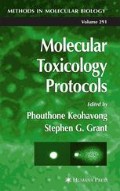Abstract
Specific recurring chromosomal translocations and deletions are found in a variety of cancers. In hematopoietic malignancies, many of these chromosomal aberrations result from mistakes involving V(D)J recombination. V(D)J recombination is required for the formation of functional T-cell receptor genes in T cells and antibody genes in B cells. This is an inherently dangerous process, however, because double-strand breaks are introduced into the chromosomes. Molecular evidence indicates that failure of the fidelity of this process results in the activation of proto-oncogenes or the inactivation of tumor suppressor genes. Here we describe sensitive, quantitative PCR assays for the measurement of such events in human lymphocytes. One assay measures the frequency of t(14;18) translocations that result in the dysfunctional regulation of the antiapoptotic gene BCL-2. The other assay measures the frequency of a deletion caused by illegitimate V(D)J recombination in the X-linked HPRT gene.
Access this chapter
Tax calculation will be finalised at checkout
Purchases are for personal use only
References
Lipford, E., Wright, J. J., Urba, W., et al. (1987) Refinement of lymphoma cytogenetics by the chromosome 18q21 major breakpoint region. Blood 70, 1816–1823.
Yunis, J. J., Oken, M. M., Kaplan, M. E., Ensrud, K. E., Howe, R. R., and Theologides, A. (1982) Distinctive chromosomal abnormalities in histologic subtypes of non-Hodgkin’s lymphomas. N. Engl. J. Med. 307, 1231–1236.
Hockenbery, D., Nunez, G., Milliman, C, Schreiber, R. D., and Korsmeyer, S. J. (1990) Bcl-2 is an inner mitochondrial membrane protein that blocks programmed cell death. Nature 348, 334–336.
Crescenzi, M., Seto, M., Herzig, G. P., Weiss, P. D., Griffith, R. C, and Korsmeyer, S. J. (1988) Thermostable DNA polymerase chain reaction amplification of t(14;18) chromosome breakpoints and detection of minimal residual disease. Proc. Natl. Acad. Sci. USA 85, 4869–4873.
Ngan, B. Y., Nourse, J., and Cleary, M. L. (1989) Detection of chromosomal translocation t(14;18) within the minor cluster region of bcl-2 by polymerase chain reaction and direct genomic sequencing of the enzymatically amplified DNA in follicular lymphomas. Blood 73, 1759–1762.
Cotter, F., Price, C, Zucca, E., and Young, B. D. (1990) Direct sequence analysis of the 14q+ and 18q-chromosome junctions in follicular lymphoma. Blood 76, 131–135.
Eick, S., Krieger, G., Bolz, I., and Kneba, M. (1990) Sequence analysis of amplified t(14;18) chromosomal breakpoints in B-cell lymphomas. J. Pathol. 162, 127–133.
Liu, Y., Hernandez, A. M., Shibata, D., and Cortopassi, G. A. (1994) BCL2 translocation frequency rises with age in humans. Proc. Natl. Acad. Sci. USA 91, 8910–8914.
Zhang, X. Y. and Ehrlich, M. (1994) Detection and quantitation of low numbers of chromosomes containing bcl-2 oncogene translocations using semi-nested PCR. Biotechniques 16, 502–507.
Fuscoe, J. C, Setzer, R. W., Collard, D. D., and Moore, M. M. (1996) Quantification of t(14;18) in the lymphocytes of healthy adult humans as a possible biomarker for environmental exposures to carcinogens. Carcinogenesis 17, 1013–1020.
Fuscoe, J. C, Zimmerman, L. J., Lippert, M. J., Nicklas, J. A., O’Neill, J. P., and Albertini, R. J. (1991) V(D)J recombinase-like activity mediates hprt gene deletion in human fetal T-lymphocytes. Cancer Res. 51, 6001–6005.
Fuscoe, J. C, Zimmerman, L. J., Harrington-Brock, K, et al. (1992) V(D)J recombinase-mediated deletion of the hprt gene in T-lymphocytes from adult humans. Mutat. Res. 283, 13–20.
Fuscoe, J. C, Vira, L. K., Collard, D. D., and Moore, M. M. (1997) Quantification of hprt gene deletions mediated by illegitimate V(D)J recombination in peripheral blood cells of humans. Environ. Mol. Mutagen. 29, 28–35.
Chen, C. L., Fuscoe, J. C, Liu, Q., and Relling, M. V. (1996) Etoposide causes illegitimate V(D)J recombination in human lymphoid leukemic cells. Blood 88, 2210–2218.
Chen, C. L., Fuscoe, J. C, Liu, Q., Pui, C. H., Mahmoud, H. H., and Relling, M. V. (1996) Relationship between cytotoxicity and site-specific DNA recombination after in vitro exposure of leukemia cells to etoposide. J. Natl. Cancer Inst. 88, 1840–1847.
Chen, C. L., Woo, M. H., Neale, G. A., et al. (1998) A human lymphoid leukemia cell line with a V(D)J recombinase-mediated deletion of hprt. Mutat. Res. 403, 113–125.
Fuscoe, J. C, Knapp, G. W., Hanley, N. M., et al. (1998) The frequency of illegitimate V(D)J recombinase-mediated mutations in children treated with etoposide-containing antileukemic therapy. Mutat. Res. 419, 107–121.
Scheerer, J. B., Xi, L., Knapp, G. W., Setzer, R. W., Bigbee, W. L., and Fuscoe, J. C. (1999) Quantification of illegitimate V(D)J recombinase-mediated mutations in lymphocytes of newborns and adults. Mutat. Res. 431, 291–303.
Edwards, A., Voss, H., Rice, P., et al. (1990) Automated DNA sequencing of the human HPRT locus. Genomics 6, 593–608.
Author information
Authors and Affiliations
Editor information
Editors and Affiliations
Rights and permissions
Copyright information
© 2005 Humana Press Inc.
About this protocol
Cite this protocol
Fuscoe, J.C. (2005). Simultaneous Quantification of t(14;18) and HPRT Exon 2/3 Deletions in Human Lymphocytes. In: Keohavong, P., Grant, S.G. (eds) Molecular Toxicology Protocols. Methods in Molecular Biology™, vol 291. Humana Press. https://doi.org/10.1385/1-59259-840-4:171
Download citation
DOI: https://doi.org/10.1385/1-59259-840-4:171
Publisher Name: Humana Press
Print ISBN: 978-1-58829-084-7
Online ISBN: 978-1-59259-840-3
eBook Packages: Springer Protocols

